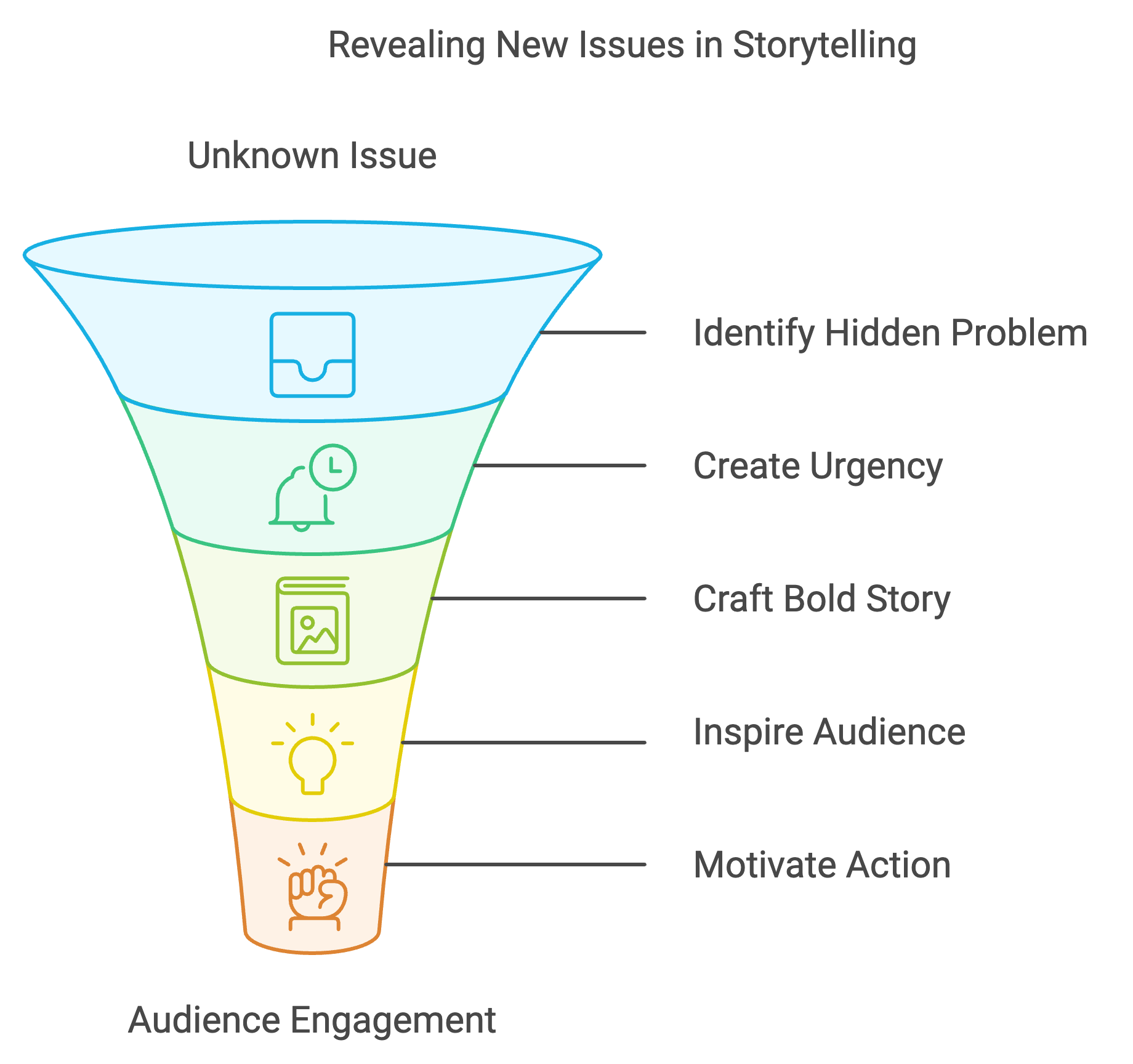Map Your Storytelling Spectrum
Storytelling is one of the most powerful tools a non-profit organization or NGO can use to raise awareness, drive donations, and inspire action. But how do you decide what kind of story will resonate most with your audience? Not every issue is the same, and your approach should vary based on how familiar your audience is with the problem and how much resistance there is to addressing it.
Here’s a simple way to think about crafting your narrative to create the most impact, inspired by The Impact Field Guide & Toolkit.
1. Revealing New Issues: Capturing Attention
When your organization is working on a problem that is largely unknown to your audience, and there isn’t much resistance to addressing it, your storytelling needs to focus on revealing the issue. Think of it as pulling back the curtain on something people don’t yet know but need to. These stories are often bold and eye-opening, exposing a hidden problem that demands immediate attention.
In these cases, it’s about creating that “Aha!” moment for the audience, where they realize the gravity of the situation for the first time. A well-crafted story in this scenario educates and inspires, motivating the audience to get involved before opposition can build.
Example:
Imagine an NGO raising awareness about a new environmental threat that hasn’t yet made headlines. The goal here is to create urgency and drama by showing the audience the unseen dangers and consequences of ignoring the problem.
2. Refocusing Attention on Familiar Issues: Renewing Commitment
Some issues are well-known but lack urgency because they’ve been in the public eye for so long. In these cases, people are aware of the problem but may feel that enough is being done or that the issue isn’t pressing anymore. The key to telling an impactful story here is to put the spotlight on the issue in a way that reawakens interest.
This is where non-profits can give the issue a fresh angle or highlight new developments that the audience hasn’t yet considered. It’s not about revealing something entirely new but about refocusing their attention and reminding them why the issue still matters.
Example:
For example, an organization working on child education may use new statistics or a personal success story to reignite public interest in a long-standing problem, such as educational inequality, by showing how the situation persists or has evolved.
3. Investigating Controversial Issues: Proving the Case
If your cause deals with an unknown issue that faces strong opposition, the challenge is not just to educate but to prove the case. These are situations where there might be significant political or social resistance to the cause, and the story needs to be fact-driven and compelling enough to break through.
In these cases, storytelling becomes a tool for investigation. The narrative must build a clear and convincing case for why the issue matters, carefully addressing opposition with evidence and testimonials. It’s a longer game that involves winning the trust of the audience while dismantling resistance.
Example:
If your organization is working to promote awareness around an underreported human rights issue, the story should focus on investigating the problem, showing both the facts and the human toll, backed by testimonials from those directly affected.
4. Humanizing Entrenched Issues: Rebuilding Connection
Some causes face strong opposition and are well-known to the audience, which can lead to a sense of fatigue. In these situations, people might feel powerless to help, or they’ve been so overwhelmed by the problem that they tune it out. To break through, the storytelling must shift from presenting facts to humanizing the issue.
In these cases, rather than trying to persuade with more data or assert more facts, the goal is to connect emotionally with your audience by showing the real people behind the statistics. By creating a human connection, you can rekindle compassion and drive action despite the fatigue or opposition.
Example:
Take an NGO working on refugee issues. Rather than rehashing the scale of the crisis, you might tell the deeply personal story of one refugee family, focusing on their struggles and triumphs to rebuild a sense of empathy and humanity in your audience.
How to Apply These Strategies
For non-profits and NGOs, understanding where your cause fits in this storytelling spectrum can help you craft more targeted, effective narratives. Whether your issue is little-known, widely familiar, or deeply entrenched in controversy, the right approach can make all the difference in how your audience responds.
Here are a few questions to consider when crafting your next story:
Is this issue widely known or relatively unknown to our audience?
How much resistance or opposition are we facing?
Do we need to educate our audience, reignite interest, prove our case, or reconnect them emotionally with the cause?
By tailoring your storytelling approach to the answers to these questions, you can better connect with your audience and inspire them to take meaningful action.
Final Thoughts
Every story you tell as a non-profit organization or NGO is an opportunity to make a difference. Whether you’re revealing a new issue, refocusing attention on a familiar problem, investigating a controversial cause, or humanizing an entrenched one, your storytelling should always be intentional and strategic.
By understanding how your audience perceives the issue and the level of opposition or support around it, you can craft stories that are not only heard but truly felt—stories that drive people to take action.






